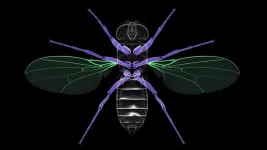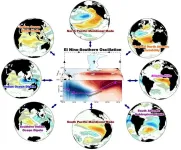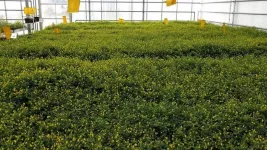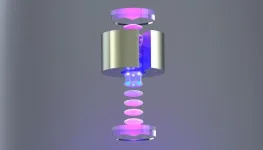(Press-News.org) Neuroscientists have discovered how the brain bidirectionally controls sensitivity to threats to initiate and complete escape behaviour in mice. These findings could help unlock new directions for discovering therapies for anxiety and post-traumatic stress disorder (PTSD).
The study, published today in Current Biology, outlines how researchers at the Sainsbury Wellcome Centre at UCL studied a region of the brain called the periaqueductal gray (PAG), which is known to be hyperactive in people with anxiety and PTSD. Their findings show that inhibitory neurons in the PAG constantly fire, which means that their level can be dialled up and down. The team found that this has a direct impact on escape initiation in mice and that the same neurons were also responsible for how long escape lasts.
“Escape behaviour is not fixed – it’s adaptable with experience. Our previous studies have shown that mice become more or less likely to escape depending on their past experience. And so, we wanted to understand how the brain regulates sensitivity to threats as this could have implications for people with anxiety and PTSD where these circuits may be misregulated,” commented Professor Tiago Branco, Group Leader at SWC and corresponding author on the paper.
To study how the brain controls escape behaviour, the team first carried out in vitro recordings from PAG inhibitory neurons (in a dish) to look at their properties. They found that in the absence of input, the PAG inhibitory neurons always fire. They confirmed this finding through in vivo recordings using calcium imaging and head mounted miniature microscopes while mice ran around. The team also performed some connectivity studies in the brain and showed that the PAG inhibitory neurons are directly connected to the excitatory neurons that are known to initiate escape.
“We found that the whole escape network is under direct inhibitory control. When we looked at what happens during escape, we found a group of cells where the activity goes down just before escape. This means that the inhibition is removed so that escape can be initiated. We also found another group of cells where inhibition gradually increases as the animal is escaping and peaks when the animal has reached the shelter. This suggests that not only do inhibitory cells control escape initiation, but they also look to be important for telling the animal to stop when they reach safety,” explained Professor Branco.
To test this further, the team used a technique called optogenetics to directly manipulate the activity of neurons by exciting or inhibiting them. When they artificially increased the activity of the PAG inhibitory neurons, they found that escape probability decreased. When they inhibited the PAG inhibitory neurons, then escape probability increased. This confirmed that the PAG inhibitory neurons are acting as dial that can be turned up and down to control how sensitive the animal is to threat.
“To check whether these neurons are also important for controlling when escape stops, we first activated the neurons after the animals had started escaping and found that they stop before they reach the shelter. Then when we inhibited the neurons, we found that mice run past the shelter and do not stop escaping. This means the neurons have access to the information that the animal uses to know when it has reached safety,” explained Professor Branco.
The next step for the team is to understand how the experience of threat makes the system more or less excitable through the recruitment of these neurons. “If we were able to reveal the specific molecular pathway that links experience to the recruitment of these neurons, then it is conceivable that drugs could be developed to target this pathway so that the sensitivity could be dialled up or down in people with anxiety and PTSD,” concluded Professor Branco.
This research was funded by a Wellcome Senior Research Fellowship (214352/Z/18/Z), by the Sainsbury Wellcome Centre Core Grant from the Gatsby Charitable Foundation and Wellcome (GAT3755 and 219627/Z/19/Z) and by a European Research Council grant (Consolidator no. 864912), German Research Foundation postdoctoral fellowships (project no. 515465001; project no. STE 2605/1), the UCL Wellcome 4-year PhD Programme in Neuroscience, the SWC PhD Programme and the Max Planck Society.
Source:
Read the full paper in Current Biology: ‘Tonically active GABAergic neurons in the dorsal periaqueductal gray control instinctive escape in mice’
Media contact:
For more information or to speak to the researchers involved, please contact:
April Cashin-Garbutt, Head of Research Communications and Engagement, Sainsbury Wellcome Centre
E: a.cashin-garbutt@ucl.ac.uk T: +44 (0)20 3108 8028
About the Sainsbury Wellcome Centre
The Sainsbury Wellcome Centre (SWC) brings together world-leading neuroscientists to generate theories about how neural circuits in the brain give rise to the fundamental processes underpinning behaviour, including perception, memory, expectation, decisions, cognition, volition and action. Funded by the Gatsby Charitable Foundation and Wellcome, SWC is located within UCL and is closely associated with the Faculties of Life Sciences and Brain Sciences. For further information, please visit: www.sainsburywellcome.org
END
Brain’s ‘escape switch’ controlled by threat sensitivity dial
Researchers reveal neurons that regulate sensitivity to threat and thereby start and stop escape behaviour in mice
2024-06-26
ELSE PRESS RELEASES FROM THIS DATE:
Improving prostate cancer screening for transgender women
2024-06-26
Transgender women are still at risk for prostate cancer. A new study led by Cedars-Sinai Cancer investigators, published in the peer-reviewed Journal of the American Medical Association, concludes that current screening guidelines could miss early-stage prostate cancer in transgender women on hormone therapy.
The prostate, a small gland that helps make semen, also produces a protein called prostate-specific antigen, or PSA. Blood levels of PSA tend to be elevated in people who have prostate cancer, and the PSA test, which measures those levels, is a common prostate ...
For healthy adults, taking multivitamins daily is not associated with a lower risk of death
2024-06-26
What: A large analysis of data from nearly 400,000 healthy U.S. adults followed for more than 20 years has found no association between regular multivitamin use and lower risk of death. The study, led by researchers at the National Institutes of Health’s National Cancer Institute, was published June 26, 2024, in JAMA Network Open.
Many adults in the United States take multivitamins with the hope of improving their health. However, the benefits and harms of regular multivitamin use remain unclear. ...
From takeoff to flight, the wiring of a fly's nervous system is mapped
2024-06-26
Work is underway on a wiring diagram of the motor circuits in the central nervous system that control muscles in fruit flies. This connectome, as the wiring diagram is called, is already providing detailed information on how the nerve coordination of leg movements differs from that controlling the wings.
Although fruit flies seem like simple creatures, the researchers said that their motor system contains “an unexpected level of complexity.”
“A typical fly motor neuron receives thousands of synapses from hundreds ...
A chip-scale Titanium-sapphire laser
2024-06-26
As lasers go, those made of Titanium-sapphire (Ti:sapphire) are considered to have “unmatched” performance. They are indispensable in many fields, including cutting-edge quantum optics, spectroscopy, and neuroscience. But that performance comes at a steep price. Ti:sapphire lasers are big, on the order of cubic feet in volume. They are expensive, costing hundreds of thousands of dollars each. And they require other high-powered lasers, themselves costing $30,000 each, to supply them with enough energy to function.
As a result, Ti:sapphire lasers ...
El Niño forecasts extended to 18 months with innovative physics-based model
2024-06-26
Across Asia, the Pacific Ocean, and the Americas, El Niño Southern Oscillation (ENSO) brings variations in winds, weather, and ocean temperature that can cause droughts, floods, crop failures, and food shortages. Recently, the world has experienced a major El Niño event in 2023-2024, dramatically impacting weather, climate, ecosystems, and economies globally. By developing an innovative modeling approach, researchers from the School of Ocean and Earth Science and Technology (SOEST) at the University ...
Scientists discover genetic ‘off switch’ in legume plants that limits biological ability to source nutrients
2024-06-26
A genetic “off switch” that shuts down the process in which legume plants convert atmospheric nitrogen into nutrients has been identified for the first time by a team of international scientists.
Legumes like beans, peas and lentils are unique among crops for their ability to interact with soil bacteria to convert or “fix” nitrogen into a usable form of nutrients. However, this energy-intensive biological process is reduced when nitrogen is already abundant in the soil either through natural processes or through the application of synthetic ...
The Frontiers Planet Prize announces 2024 International Champions
2024-06-26
The Frontiers Planet Prize today (26 June) announced its 2024 International Champions. The Prize recognizes and rewards scientists whose groundbreaking research accelerates solutions to help humanity remain safely within the nine planetary boundaries. The three winning scientists, Dr Pedro Jaureguiberry, Instituto Multidisciplinario de Biología Vegetal (Argentina), Prof Dr Peter Haase, Senckenberg Society for Nature Research (Germany), and Prof Jason Rohr, University of Notre Dame (USA), were each awarded 1.1 million (USD) / 1 million (CHF) to support their research.
The International Champions award-winning research ...
Precision instrument bolsters efforts to find elusive dark energy
2024-06-26
Dark energy — a mysterious force pushing the universe apart at an ever-increasing rate — was discovered 26 years ago, and ever since, scientists have been searching for a new and exotic particle causing the expansion.
Pushing the boundaries of this search, University of California, Berkeley physicists have now built the most precise experiment yet to look for minor deviations from the accepted theory of gravity that could be evidence for such a particle, which theorists have dubbed a chameleon or symmetron.
The experiment, which combines an atom interferometer for precise gravity ...
Overcoming challenges encountered by Spanish-speaking trauma patients
2024-06-26
Key Takeaways
Spanish-speaking patients who suffer traumatic injuries face gaps in their care once they leave the hospital, many with a high need for mental health services.
More than half of the patients studied reported food insecurity, transportation challenges, and needing help with utilities.
A novel care pathway developed by researchers can help connect these patients with needed services.
CHICAGO – Many trauma patients face a myriad of challenges when recovering from a traumatic injury, ...
Every walk you take: Promoting active and healthy ageing of citizens
2024-06-26
Promoting active and healthy ageing of citizens through a new mobile application that shows walking routes through green areas in Barcelona with data on geolocation, obstacles, pollution and weather in real time: this is the aim of the citizen science project Every Walk You Take, promoted by a team from the University of Barcelona. This initiative aims to promote physical activity and health among the over-fifty-five population through a new mobile-assisted health intervention (mHealth).
This innovative app, presented in an article published in Sustainability ...
LAST 30 PRESS RELEASES:
Scientists trace microplastics in fertilizer from fields to the beach
The Lancet Obstetrics, Gynecology, & Women’s Health: Taking paracetamol during pregnancy does not increase risk of autism, ADHD or intellectual disabilities, confirms new gold-standard evidence review
Taking paracetamol during pregnancy does not increase risk of autism, ADHD or intellectual disabilities
Harm reduction vending machines in New York State expand access to overdose treatment and drug test strips, UB studies confirm
University of Phoenix releases white paper on Credit for Prior Learning as a catalyst for internal mobility and retention
Canada losing track of salmon health as climate and industrial threats mount
Molecular sieve-confined Pt-FeOx catalysts achieve highly efficient reversible hydrogen cycle of methylcyclohexane-toluene
Investment in farm productivity tools key to reducing greenhouse gas
New review highlights electrochemical pathways to recover uranium from wastewater and seawater
Hidden pollutants in shale gas development raise environmental concerns, new review finds
Discarded cigarette butts transformed into high performance energy storage materials
Researchers highlight role of alternative RNA splicing in schizophrenia
NTU Singapore scientists find new way to disarm antibiotic-resistant bacteria and restore healing in chronic wounds
Research suggests nationwide racial bias in media reporting on gun violence
Revealing the cell’s nanocourier at work
Health impacts of nursing home staffing
Public views about opioid overdose and people with opioid use disorder
Age-related changes in sperm DNA may play a role in autism risk
Ambitious model fails to explain near-death experiences, experts say
Multifaceted effects of inward foreign direct investment on new venture creation
Exploring mutations that spontaneously switch on a key brain cell receptor
Two-step genome editing enables the creation of full-length humanized mouse models
Pusan National University researchers develop light-activated tissue adhesive patch for rapid, watertight neurosurgical sealing
Study finds so-called super agers tend to have at least two key genetic advantages
Brain stimulation device cleared for ADHD in the US is overall safe but ineffective
Scientists discover natural ‘brake’ that could stop harmful inflammation
Tougher solid electrolyte advances long-sought lithium metal batteries
Experts provide policy roadmap to reduce dementia risk
New 3D imaging system could address limitations of MRI, CT and ultrasound
First-in-human drug trial lowers high blood fats
[Press-News.org] Brain’s ‘escape switch’ controlled by threat sensitivity dialResearchers reveal neurons that regulate sensitivity to threat and thereby start and stop escape behaviour in mice







